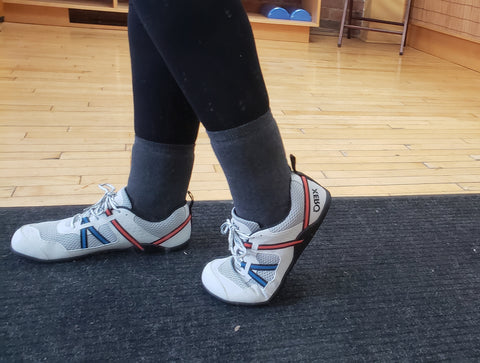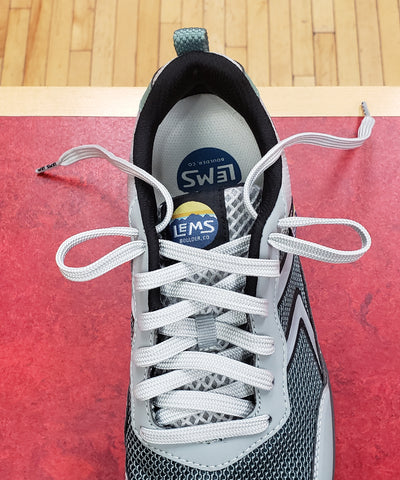My shopping cart
Your cart is currently empty.
Continue ShoppingSomething that surprised me when I started fitting customers for minimal shoes is how frequently people would ask me to check if the shoe they were trying on was the right size for them. But looking back on it, I didn't always know how to tell if a shoe fit either!
Cramming my toes into shoes that were too small or pointy made sense to me at one point, because I didn't know that shoes don't have to hurt. It took someone buying me my first pair of minimal shoes and going out and wearing them to start understanding the type of fit I was really looking for. The more experience I have with trying on different models and brands-- and wearing them in everyday life-- the more I learn my own needs.
I also have the unique experience of watching other people try on shoes as part of my work, and there are a few general guidelines I've found for getting the right fit for our customers, both from research and experience. I'm always learning like every human, but so far these guidelines have served me well, and I hope they'll help you figure out if you're happy with your new CEM shoes, whether they're your first pair of minimal shoes or your hundredth!
We recommend taking a look at our sizing guide, because there's more to your feet than their length measurement, too. Take a look at your feet! The shape of your footprint can tell you the shape of the shoe that would best suit you, such as (from a bird's eye perspective) one with a sloped toe box or one that's more square.

We traced our feet at CEM to get a sense for the shapes. Find measuring instructions in our Sizing Guide- this method is unreliable for taking measurements.
That's a two dimensional view though, and both feet and shoes exist in three dimensions. Some shoes are shallower or deeper height-wise in the toebox, around the instep, etc. With boots, the contour of your heel and ankle can also be a factor in finding the best fit. Ideally the arch of the shoe also lines up with your arches, though your arches may change if you're transitioning into minimal shoes. The more the shoe mimics the shape of your foot, the better the fit will be!

Two different boot volumes.

Two different heel shapes.
You won't always find the perfect match-- there are as many feet shapes as there are people, and only so many shoe models. Just try to get as close as possible within the options available for the type of shoe you need. To get familiar with different ways of describing the shape of your feet, we love to recommend this Anya's Reviews article: https://anyasreviews.com/best-barefoot-shoes-foot-type/

How long should your shoes be? The rough answer is that the inside of the shoe should be 5-15mm longer than your foot, depending on your fit preference. A thumb's width is another common guideline for how much "extra" room you want inside the shoe, in front of your longest toe. The space in front of your toes will help you get the same range of motion you'd get in bare feet.
Consider the material the shoe is made of, especially the uppers, which are the sides and top of the shoe. For a shoe with soft uppers which stretch or foamy uppers that form to the shape of your foot, you can get away with less room. For shoes that have harder uppers and uppers that don't stretch, you need to ensure you have lots of room.

Do your toes touch the front when your foot bends?
You can check for sufficient length with a little test, too: while standing, leave the front part of your foot on the ground but raise your heel (your knee will bend). Just do one side at a time for balance. This mimics how your foot moves inside the shoe during the push-off part of gait. If your toes touch the front when you do this test (and the shoe doesn't stretch or mould to use), going up half a size will likely be better. If your toes touch the front when you're just standing with your feet flat on the floor without bending, try a full size up.

The insole test can help you figure out how much room you have inside the shoe visually. Take the insoles out of the shoes and place them on the floor. Stand on them (rather than sitting) to ensure your weight is fully on your feet the way it would be when you're wearing them.

The heel is comfortably inside the heel cup here.
Now you can see how much room you have inside the shoe. Your heels should be comfortably inside the heel cup rather than at the very edge, the way they would be if you were wearing the shoe with the insole. Now you can see (or even measure) the difference between where your foot ends and where the insole ends.

Now you can see how much room there is and where.
Once you have the right length, are they wide enough? Keep in mind that shoe width scales with different sizes for our brands, so a size 7 and a size 13 of the same model will have greatly different widths.


While you have those insoles out, check them for width, too. The photo on the right looks good!
You can use the insole test to get a visual sense of the width as well. You don't need extra room with the width like you do for the length, but ideally your foot doesn't fall off the sides of the insole. If your feet are just slightly wider than the insole that should be fine (a millimeter or two) but if much of your foot doesn't fall within the boundary of the insole widthwise, that shoe isn't wide enough for you.
Test the width of the shoe again by putting the insole back in the shoe and wearing them, walk around the room a bit. Do you feel any pressure? You should feel no pressure for a perfect fit, and free to move around with ease.
Move around in the shoes. Have someone watch you walk around the room if possible. If you keep thinking about the way you're walking (which makes you walk funny), try giving yourself a different topic to think about such as a favourite food. Let the analysis be their job. Test various walking speeds, such as a gentle stroll versus the walk you might use when you're in a hurry.
Are there any areas that feel off when you're moving around? Pressure spots are the first thing to look for, excessive friction is another. Your feet should be secure in the shoe: the shoe should move how you move. Some styles are less flexible than others (helpful for folks new to minimal or for specific activities) but heel slippage and super loose fitting shoes can negatively affect the way you move.
While you're moving about in them, check for wobbling in the ankle or feet rolling inwards. If you're rolling in a lot or having involuntary wobbling you might need a model with less instability or more ground contact. Check out our article on arch support for more information on getting stronger so you don't over-pronate.

This photo demonstrates rolling inwards, but rolling outwards can happen too. A little is fine, a lot gives pause. Can you balance on one foot with similar stability to your barefoot balance?
Ultimately it comes down to this: do you like the way the shoes feel? Are they comfortable? Do you like moving around in them? If you love the way the shoes feel after a half hour of walking around the house, it's probably a great fit!
In many cases a small adjustment can make the difference between disappointment and loving your new shoes! Here are a few ideas to try before exchanging for a new size or different model.
If the shoe you're trying has a removable insole, try them on without the insole. This can slightly increase the room inside the shoe in length, width, and height. It also increases the amount of feedback you get from the ground.
If there's too much height inside the shoe for a secure fit, try adding a second insole! You'll get slightly less groundfeel but it may fix the fit. We recommend one that is as flat and flexible as possible, and wool is a great insole material if you use it. We have a couple of options in the 22-33$ range, but you can also DIY your own like this.
If the shoe has laces, try adjusting the lacing tension or using a different lacing method. There are so many lacing methods and many are decorative, but many have functional purposes too.

Showing two different types of functional lacing: lower down, the laces twist and go back to the next eyelet on the same side to decrease volume. Around the ankle we have paratrooper lacing for extra security.
You can use lacing adjustments to increase or decrease mobility, change the available volume in different areas of the shoe, help break in a new pair, or change the length of tying-off lace at the top. Take a look here for one you like.
If you have an athletic model with an extra eyelet, try the heel lock tie aka runner's loop tie to secure the shoe around the heel and over the instep and prevent friction. Find instructions on lock lacing here.
Lock lacing in three steps...

Step 1: create a loop

Step 2: thread the laces through the opposite loop

Step 3: tighten, then tie as usual.
If you have a boot, try not using the top eyelet (lacing hole) or even the top few eyelets so that you have freer movement during the break-in period.

Too-long laces from not using the top few eyelets? Just wrap it around.
You've tried out different ways to wear the shoe and it's just not working, so now you need a different size or model. If you're not sure what might help, feel free to send a brief description (photos too if you think they'd help) of what is and isn't working for you and we'll do our best to recommend alternatives.
You can find our return and exchange info here.
With sandals, you can see your foot on the footbed and whether it falls off the side when you're standing and moving. Since you won't bump into the end of the shoe in an open-toe sandal, you don't need too much extra room, in fact a lot of extra material in the front of a sandal could be a tripping hazard. If you can move comfortably and your sandals look and feel good, you'll probably know it's a good fit.

The sandal on the left has overhang (too small), and the one on the right is too long: you can see that the anatomy of the foot isn't lined up with where the shoe is meant to hold it.
The lacing/strap tension in different areas of the sandal can make a huge difference to the fit, so make sure those are properly adjusted. This can take some time and patience but once you find the right tension it should pretty well stay there. Sometimes the sandal just isn't right for you based on the shape or the feel, too, and that's ok. You can see the sandal return policy in the link above as well.